

Understanding the importance of Fire Risk Assessments
We are often asked “What is a Fire Risk Assessment?” This document should be the cornerstone of your fire safety plans for your specific building. Unfortunately, assessments are often overlooked, leading to unnecessary fire risks and potential loss of life.
What is a Fire Risk Assessment?
At it’s core, a Fire Risk Assessment (FRA) is a comprehensive review of a building to evaluate fire risk and provide recommendations for enhancing safety. It involves identifying potential fire hazards, evaluating the risk these hazards pose, and suggesting measures to mitigate them.
Legal Guidelines Around Fire Risk Assessments
There are specific legal requirements that must be adhered to:
- Regular Reviews: Fire Risk Assessments must be reviewed regularly. It is recommended to follow these intervals:
- Annually, after the original assessment.
- When there are significant changes to the building’s layout.
- When the building’s purpose changes substantially.
- When the nature of the occupants changes considerably.
- Documentation Requirement from October 2023: If your premises or block of flats has even one regular occupant, employee or resident, the FRA must be documented. Previously, this was required for buildings with five or more occupants.
- Recording Findings and Actions: The Fire Risk Assessment must include:
- A detailed review of the fire safety status of the premises.
- A list of recommendations to ensure the building is fire safety compliant.
Who is responsible for the fire risk assessment?
By law, every business and block of flats must have a designated “Responsible Person” accountable for fire safety. This person ensures that relevant fire safety duties are caried out and that actions are taken to prevent fires ad protect occupants if a fire occurs.
- For Small Business Owners: The owner is typically the Responsible Person unless this is delegated to someone else in the team.
- For Residents in Blocks of Flats: The Responsible Person is usually the landlord, managing company, or a member of the Residents’ Association. They are responsible for common areas, while residents must ensure their own flats are fire-safe.
How to access your building's fire risk assessment
As an occupant, you have the right to access your building’s Fire Risk Assessment. Start by contacting the Responsible Person. If you’re unsure who this is, the business owner, facilities department, landlord, or managing agent are good places to start. If your building lacks a valid FRA, request that one be conducted immediately. If your concerns are not addressed, contact your local fire brigade.
What gets reviewed in a fire risk assessment?
Fire Risk Assessments are thorough and consider various factors, depending on the building’s complexity. Typical factors reviewed include:
- Building use, layout, and construction.
- Number and nature of occupants, including vulnerable individuals.
- History of fire incidents.
- Potential ignition sources, such as electrical equipment.
- Smoking areas and prevention measures.
- Arson prevention strategies.
- Heating devices and their safety.
- Lightning protection.
- General housekeeping and combustible material management.
- Fire hazards introduced by building works or contractors.
- Storage of flammable liquids.
- Configuration and maintenance of escape routes.
- Measures to limit fire spread, like compartmentalisation.
- Emergency lighting installation and maintenance.
- Fire safety signage.
- Means of raising the alarm.
- Proper fire extinguisher placement.
- Installation and maintenance of fire safety devices like sprinklers.
- Fire safety management and its effectiveness.
- Fire safety training and evacuation drills.
- Maintenance and testing procedures for fire safety systems.
- Documentation and record-keeping of fire safety measures.
Who can Carry out a Fire Risk Assessment?
A Fire Risk Assessment must be conducted by a “competent Person”. While this doesn’t necessarily require a qualified Fire Risk Assessor we would recommend it due to their detailed training and knowledge of legal requirement and guidelines.
The individual must be competent in assessing all relevant factors and capable of:
- Clearly recording significant findings.
- Developing and implementing a fire safety action plan.
- Keeping the document updated.
Penalties for Non-Compliance
Failure to conduct a FRA and implement necessary fire safety precautions can result in sever fines or in cases of extreme negligence, imprisonment.
Contact Us
We hope this guide has helped. If you would like to discuss your building’s specific requirements or book an assessment with our expert team, please call us on 01832 735874 or email us at admin@hasaw.couk





